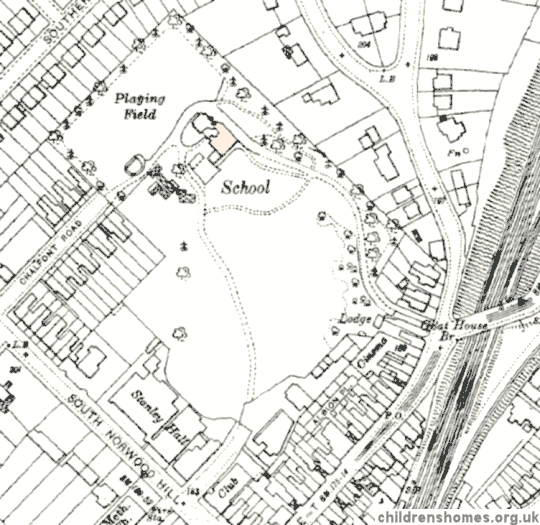Cumberlow Lodge, South Norwood, London
Cumberlow (or Cumberlow Lodge as it later became known) was built in around 1878 as a residence for the inventor and philanthropist William Ford Robinson Stanley, who himself designed the building. The property occupied a six-acre site, formerly a brick field, in South Norwood. The property's original address was 1 Lancaster Road but later changed to Chalfont Road, which became the access route into the site.
The Cumberlow Lodge site is shown on the 1933 map below, the main building marked as 'School'.

Cumberlow Lodge site, South Norwood, c.1933.
After Stanley's death in 1909, the property passed to the Lewisham Poor Law Union who used it as a Receiving Home for pauper children coming into their care.
In 1930, the site was taken over by the London County Council, who now administered the poor relief system across the capital. The Council decided on a new use for the premises and on 17 June 1935, Cumberlow Lodge was formally certified for use as an Approved School for Senior Girls. The establishment accommodated 30 up to girls, aged between their 15th and 17th birthdays at their date of admission. The girls received domestic training and instruction in gardening.
The School had an Auxiliary Home, known as Cumberlow Lodge Hostel, at 35 Lancaster Road, which could accommodate 10 girls. It was used to house girls going out to work in the area, prior to their being released on licence.
During the Second World War, the inmates were evacuated to WW2 to Addington Manor, near Winslow, Buckinghamshire. They returned to South Norwood after the war but in August, 1949, the Council announced that the School was to close.
In 1950, the premises were re-opened as the Cumberlow Lodge Remand Home for Girls, housing up to 24 girls, aged from 14 to 15, who were awaiting court proceedings. A subsequent expansion of the buildings increased its capacity to 45 places. In around 1964, the site was taken over by the Lambeth Borough Council, and later passing to Croydon Borough Council.
After the Home was closed, the site became the subject of a long-running controversy and wrangling between the Council, local residents and its new owners, Fairview New Homes Ltd., who demolished the Lodge in 2006, days after English Heritage announced they were considering listing the building. Planning permission for the construction of modern housing on the site was finally granted in 2010.
Records
Note: many repositories impose a closure period of up to 100 years for records identifying individuals. Before travelling a long distance, always check that the records you want to consult will be available.
- The
Ancestry UK
website has two collections of London workhouse records (both name searchable):
- The Find My Past website has workhouse / poor law records for Westminster.
-
London Metropolitan Archives, 40 Northampton Road, London EC1R OHB.
Holdings include:
- Children's Home Admission and Creed Registers (1930-35).
- Approved School Registers (1935-48); Punishment books (1936-49); Log books; Warden and Medical Reports (1943-55); etc.
- Remand Home Registers; Log books; etc..
- Photographs (1936-54); etc.
- Lambeth Archives, Minet Library, 52 Knatchbull Road, London SE5 9QY. Had Building plans, correspondence etc.
- The National Archives, Kew, Richmond, Surrey, TW9 4DU. Had Inspection Reports etc.
Bibliography
- Higginbotham, Peter Children's Homes: A History of Institutional Care for Britain's Young (2017, Pen & Sword)
- Hyland,Jim Yesterday's Answers: Yesterday's Answers: Development and Decline of Schools for Young Offenders (1993, Whiting and Birch)
- Millham, S, Bullock, R, and Cherrett, P After Grace — Teeth: a comparative study of the residential experience of boys in Approved Schools (1975, Chaucer Publishing)
Links
- The Therapeutic Care Journal — has a number of articles relating to Approved Schools.
Except where indicated, this page () © Peter Higginbotham. Contents may not be reproduced without permission.


